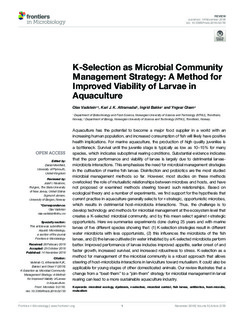| dc.contributor.author | Vadstein, Olav | |
| dc.contributor.author | Attramadal, Kari | |
| dc.contributor.author | Bakke, Ingrid | |
| dc.contributor.author | Olsen, Yngvar | |
| dc.date.accessioned | 2018-12-14T09:21:58Z | |
| dc.date.available | 2018-12-14T09:21:58Z | |
| dc.date.created | 2018-12-03T11:48:56Z | |
| dc.date.issued | 2018 | |
| dc.identifier.citation | Frontiers in Microbiology. 2018, 9 (2730), . | nb_NO |
| dc.identifier.issn | 1664-302X | |
| dc.identifier.uri | http://hdl.handle.net/11250/2577690 | |
| dc.description.abstract | Aquaculture has the potential to become a major food supplier in a world with an increasing human population, and increased consumption of fish will likely have positive health implications. For marine aquaculture, the production of high quality juveniles is a bottleneck. Survival until the juvenile stage is typically as low as 10–15% for many species, which indicates suboptimal rearing conditions. Substantial evidence indicates that the poor performance and viability of larvae is largely due to detrimental larvae-microbiota interactions. This emphasises the need for microbial management strategies in the cultivation of marine fish larvae. Disinfection and probiotics are the most studied microbial management methods so far. However, most studies on these methods overlooked the role of mutualistic relationships between microbes and hosts, and have not proposed or examined methods steering toward such relationships. Based on ecological theory and a number of experiments, we find support for the hypothesis that current practise in aquaculture generally selects for r-strategic, opportunistic microbes, which results in detrimental host–microbiota interactions. Thus, the challenge is to develop technology and methods for microbial management at the ecosystem level that creates a K-selected microbial community, and by this mean select against r-strategic opportunists. Here we summarise experiments done during 25 years and with marine larvae of five different species showing that: (1) K-selection strategies result in different water microbiota with less opportunists, (2) this influences the microbiota of the fish larvae, and (3) the larvae cultivated in water inhabited by a K-selected microbiota perform better. Improved performance of larvae includes improved appetite, earlier onset of and faster growth, increased survival, and increased robustness to stress. K-selection as a method for management of the microbial community is a robust approach that allows steering of host–microbiota interactions in larviculture toward mutualism. It could also be applicable for young stages of other domesticated animals. Our review illustrates that a change from a “beat-them” to a “join-them” strategy for microbial management in larval rearing can lead to a more sustainable aquaculture industry. | nb_NO |
| dc.language.iso | eng | nb_NO |
| dc.publisher | Frontiers Media | nb_NO |
| dc.rights | Navngivelse 4.0 Internasjonal | * |
| dc.rights.uri | http://creativecommons.org/licenses/by/4.0/deed.no | * |
| dc.title | K-selection as microbial community management strategy: A method for improved viability of larvae in aquaculture | nb_NO |
| dc.type | Journal article | nb_NO |
| dc.type | Peer reviewed | nb_NO |
| dc.description.version | publishedVersion | nb_NO |
| dc.source.pagenumber | 17 | nb_NO |
| dc.source.volume | 9 | nb_NO |
| dc.source.journal | Frontiers in Microbiology | nb_NO |
| dc.source.issue | 2730 | nb_NO |
| dc.identifier.doi | 10.3389/fmicb.2018.02730 | |
| dc.identifier.cristin | 1638354 | |
| dc.relation.project | Norges forskningsråd: 247558 | nb_NO |
| dc.description.localcode | Copyright © 2018 Vadstein, Attramadal, Bakke and Olsen. This is an open-access article distributed under the terms of the Creative Commons Attribution License (CC BY) | nb_NO |
| cristin.unitcode | 194,66,15,0 | |
| cristin.unitcode | 194,66,10,0 | |
| cristin.unitname | Institutt for bioteknologi og matvitenskap | |
| cristin.unitname | Institutt for biologi | |
| cristin.ispublished | true | |
| cristin.fulltext | original | |
| cristin.qualitycode | 1 | |

